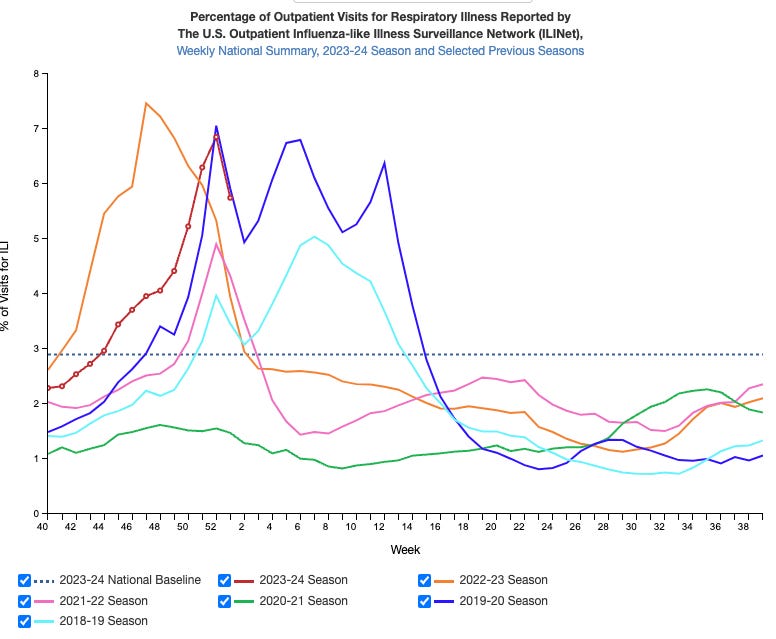Welcome to Outbreak Outlook! This is the free, national version. Paid subscribers can access regional editions of the newsletter, which contain more local information. Not signed up yet but interested in getting the regional insights? Subscribe and follow these easy instructions at this link.
Respiratory Diseases
ILI
Progress has been made! For the first time since October, influenza-like illness (ILI) activity fell this past week. During the week ending January 6th, 5.7% of visits to the doctor were for fever plus cough or sore throat. This is a substantial decline compared to 6.8% the prior week.
Now, it's not uncommon to see ILI rebound after brief dips. For example, in the 2019-2020 season, there were four separate peaks. That was also the year that Covid-19 emerged, so some of that activity was likely early coronavirus spread. The 2018-2019 season saw a second peak as well.
Still, I am encouraged by the declining ILI indicators this week and hope to have continued good news to report next week.

By region: The number of states reporting very high ILI levels fell from 22 last week to 14 this week. The South continues experiencing intense activity, with states like South Carolina, Tennessee, Louisiana and New Mexico remaining at the highest tier of ILI activity. In contrast, the Midwest, Northeast and more northern Western states are showing improvements.
By age: ILI activity declined across all age groups. People ages 5-24 saw the most improvement, with activity falling from almost 10% down to 7.3%. The 0-4 age bracket, perpetually burdened by high ILI, also improved, dropping from 15.5% down to 13.5%. Older age groups fell as well.
By severity: Reassuringly, the number of new hospital admissions for influenza also fell, confirming the ILI declines seen in outpatient clinics represent a true drop rather than a blip. New admissions decreased from around 21,000 down to 18,500 week-over-week. One caveat is hospital reporting fluctuates, so these numbers are more illustrative than comprehensive.
COVID-19
Covid-19 hospitalization rates keep increasing in many states as we progress through January. Nationally, there were 11 new hospital admissions per 100,000 residents on average. This is slightly below what we saw this time last year, at 14 new admissions.
The Northeastern region is most affected. New York and New Jersey in particular continue to have high levels of activity. Activity is also rising in other northeastern states.
Covid-19 remains elevated in many other areas as well. States like Delaware, Virginia, West Virginia, Kentucky, Tennessee and North Carolina are maintaining over 10 hospitalizations per 100,000. Others such as Alabama, Georgia, Maryland, Texas and Arkansas saw more moderate rises but remain elevated.
On the bright side, I am seeing some glimmers of hope. Wastewater concentration fell in the South, Midwest and Northeast. Only the Western region saw rising levels of SARS-CoV-2 in wastewater. Emergency department visits for Covid-19 also declined in every age group, and test positivity fell (very) slightly. I hesitate to make too much of these signs just yet, but I’m hopeful we’ll be through the worst of it soon.
RSV
Good news for RSV too! I believe we are past peak RSV season now in most, if not all, areas of the country. At the national level, PCR test positivity finally dipped below 10% this past week - the first time since October. Emergency department visits and hospitalizations are declining as well, showing relieving trends after a long and difficult season. (I don’t know why antigen test positivity, show by the orange line in the plot below, has rebounded. I find PCR test positivity a more reliable indicator.)
As of end of 2023, 18% of older adults had received the new RSV vaccine. This remains below the coverage seen for COVID-19 and flu vaccines (though those encompass all adult age groups, not just seniors). With this being the first year of RSV vaccine availability, I hope to see higher uptake next season as awareness and access continues improving.
Food recalls
The following foods are being recalled because they are contaminated. Please check your cupboards and throw out any of these items:
New
Tons of different granola and oatmeal products from Quaker -- more items were added to the list of contaminated products (more info).
Previously reported:
Charcuterie meats sold by Fratelli Beretta (more info)
Ground beef sold by Valley Meats and Scanga Meat (more info, more info)
Tons of different granola and oatmeal products from Quaker (more info).
Pet food sold by Blue Ridge Beef (more info). Pet food can pose a risk to humans through cross contamination.
If you have food allergies, you may wish to review these FDA safety alerts and USDA alerts for foods with undeclared allergens.
In other news
This is my 12th week in a row writing Outbreak Outlook updates, and I’m running out of steam! I hope you don’t mind if I skip the norovirus (it’s rising and will continue to do so until early spring) and In Other News sections this week for a bit of a respite.




Dr. Rivers, your summaries of the overwhelming data that is out there is SO helpful to us all. I trust you and value your thoughts. Thank you for truly making a difference to the world.
Thank you for this work and for the glimmer of good news.